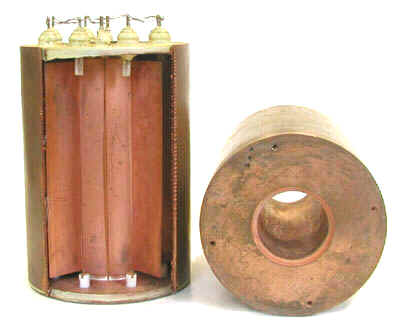Chalk River Anticoincidence Shields (ca. 1950s)
This device is described as an "Anti-Coincidence Annular Counter Type ACA-1" that was designed for use with the AECL (Atomic Energy of Canada Limited) Type BM-1 end window Geiger Mueller counter. A description can be found in AECL Publication 223 (GPI-17). In effect, it is a shield that was used to reduce the GM detector's background counts that were due to cosmic rays. The cosmic rays of concern are primarily high energy charged particles called muons.

The photograph to the left shows two of these units. The one standing upright has a portion of its outer wall removed so that the internal components can be seen.
Each of these is 6" tall and 4" in diameter. The central channel, in which the end window GM detector would be positioned, is 1 1/2" in diameter. The annular body is partitioned into eight interconnected chambers each of which has a anode running along its length. While the anode is too thin to be visible in the photograph, the small white insulators at each end of the anode can be seen for two of the interior chambers.
The two gas line connections on the top of the upright counter are not easy to recognize because of the electrical connections for the eight subchambers.
When a sample was being counted, the GM detector would be placed inside the shield's central channel so that the GM's end window was located at the bottom of the shield. If the annular shield and the GM detector each produced a pulse at the same time (i.e., in coincidence) it would be assumed that the pulses were due to a cosmic ray interaction and would not be registered. If the GM detector produced a pulse without a simultaneous pulse from the annular shield, the pulse would be assumed to be due to a charged particle (alpha or beta) from the sample.
By definition, anticoincidence shields (also known as guard detectors) are used for low level counting. It is therefore important that they be made of materials that are as free as possible from man-made or natural radioactivity. To this end, the system was assembled using a special resin adhesive rather than solder to fasten the joints.
Donated by Chalk River Laboratories.
